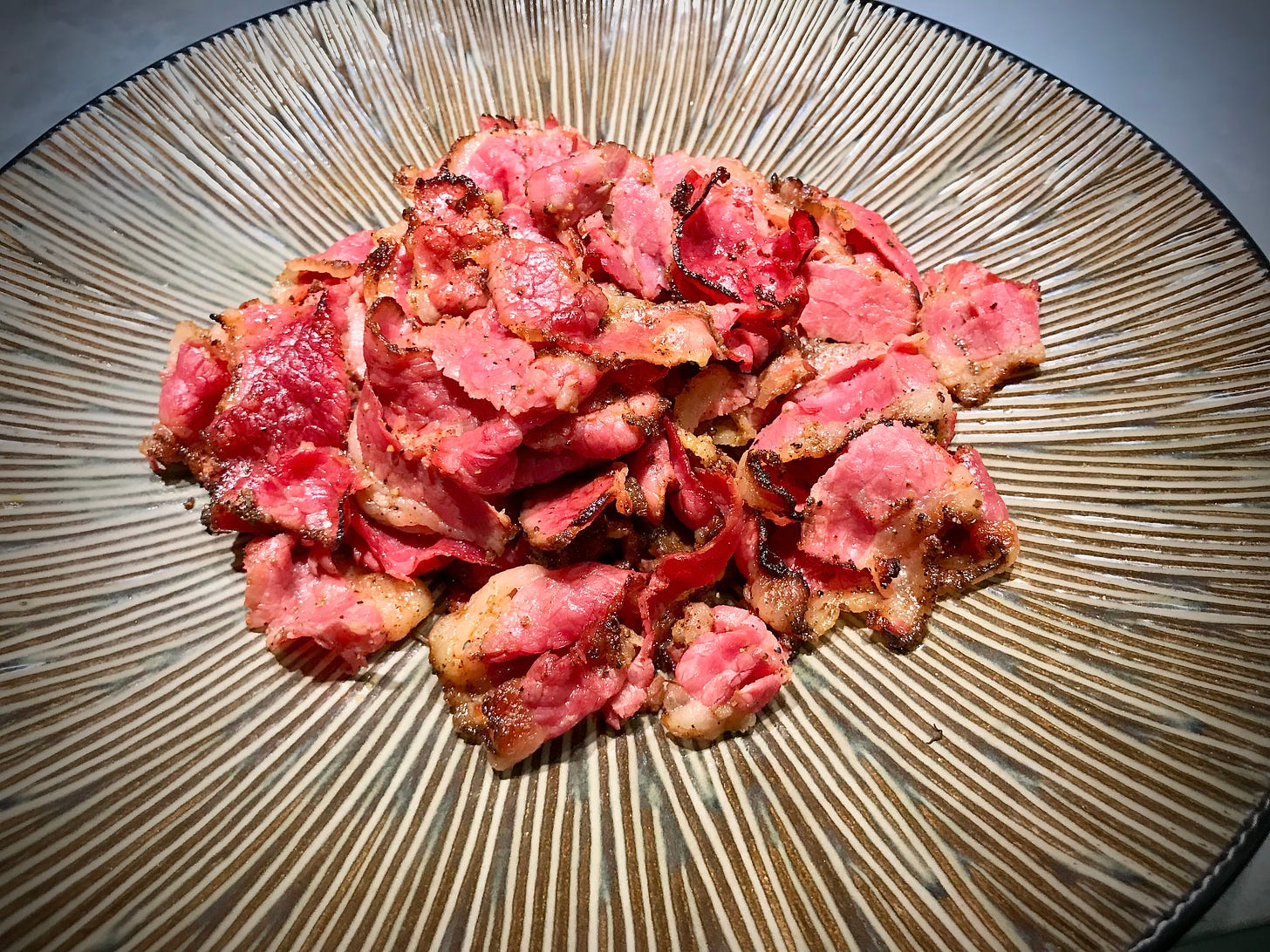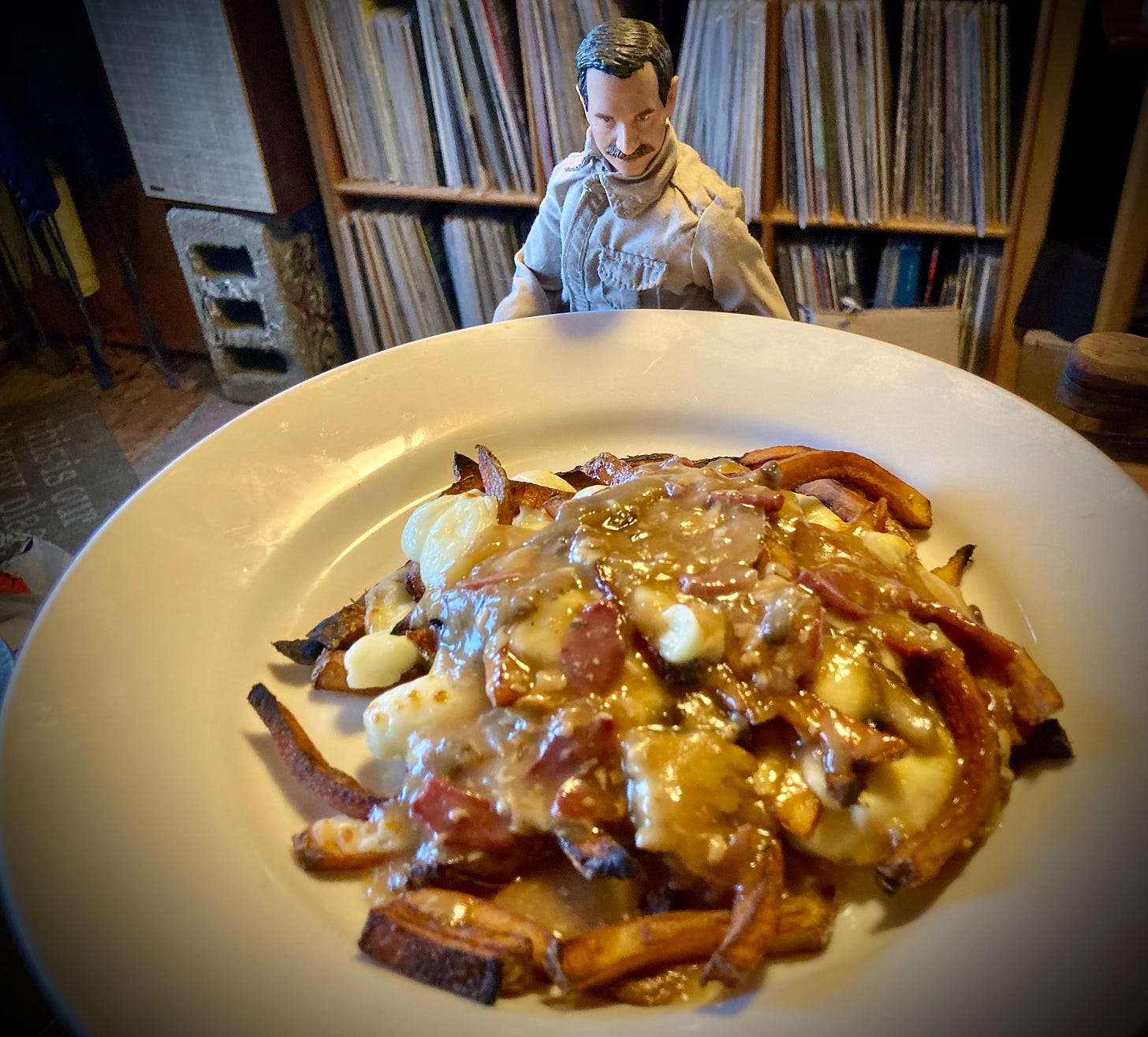
Amongst the many animal parts that face rejection from American eaters rests prominently the tongue. People just say “no.” But, in the echelon of flavor: tongue, jowls, cheeks and tail are at the top step. The most used muscles are the most flavorful. They require special care in processing and cooking unless you want the texture of thick, strong wet leather. In the case of ruminants, like cattle and deer, the tongue works continuously for a good part of the day. The muscles have high endurance, lots of slow twitch fibers and in my opinion present the defining flavor for each animal. If you want know the real flavor of cattle, try some tongue. The key is to break down the components of the muscle fibers slowly to soften the texture to a satisfying state. Generally, a 3-4 hour braise will soften even the most recalcitrant of tongues.
At The French Laundry, for many years they have served a dish called “TONGUE IN CHEEK” which wraps slow-cooked tender cattle cheeks around delicately cooked veal tongue. It is a stunning and delicate textured dish. The fantastic flavors are divinely rendered by Thomas and his staff. Fortunately, it doesn’t take their level of skill and precision to make these high-use muscles delicious. We can do it too.
Corning
On a recent trip to Portland, ME, I stopped at the french fry and poutine bistro called Duck Fat. They have been in operation for 25 years and are known for their duck fat cooked fries. To go with my small order of fries, I went for a daily special of corned cattle tongue or lingua de vaca, served with lacto-slaw, grain mustard and grilled batard. Their version was good. Inspiring with the slaw and mustard.
I have been making corned meats for about 10 years now. And probably about the same for tongues, tails and cheeks. But it had never occurred to me to corn and low-and-slow together. I left thinking I needed to corn the [many] tongues I had in my freezers. Forehead slap!
The terms “corning” and “corn” emerged in the 16th century. Salt at that time was typically in small seed like pieces, looking not unlike corn with an off-white color. Curing was done with meat and fish combined with “corns” of salt. Hence, “corning.” In modern times, corning generally means immersing meat or sometimes fish in a salt brine with seasonings. In the case of modern “corned beef,” the meat is typically a cattle round roast that is soaked in a seasoned salt brine with the addition of curing salt, aromatics and some sugar
I got started with corning after learning to make dry cured meats like bacon [good bacon is dry cured, commercial bacon of varying grades are wet cured,] pepperoni, coppa, capicola, guanciale. My goal was to make high quality pastrami after being disappointed with what I could buy locally. Pastrami and the similar Montreal Smoked Meat are basically corned meats. Instead of being steamed or boiled after brining, they are rinsed, dry rubbed and then hot smoked. Triple preserved. The combination of salt brine, spicy dry rub and smoking gives bad bacteria and such a serious kick down the road. While I didn’t test the theory, the stuff would likely keep at room temperature for a surprising length of time.
It’s worth searching “history of pastrami” if you are really into food history. The short version: Ottoman Turks would dry cure meat with salt “corn,” rub it with spices, then tie it to their saddles where it would get “pressed” on their trips to absorb the dry rub and salt and remove any remaining moisture. Mutton, goat and cattle were commonly used. At some point the technique made it to Romania, where the preferred meat became goose. I have made Canada Goose pastrami a number of times and it is outstanding. Eventually, the Romanians came to New York and took to making pastrami from brisket because it was so inexpensive. Well, today I’m sorry to say that is no longer true thanks to BBQ and the internet. But nonetheless, the modern version is usually made with a cattle brisket, wet brined, rubbed with pepper and coriander and then smoked.
I have made probably a dozen batches of smoked meat/pastrami over the last decade and have made many fans amongst my friends—especially the New Yorkers. I do break with NY tradition by shaving the pastrami and then broiling it versus the steamed, thicker sliced meat you’ll get at Katz or equivalent. I have yet to get any complaints with the broil method—and I usually broil on some good swiss at the end on the way to a pastrami reuben or pastrami and swiss on rye. I have also made pastrami with the shoulder of a sow hog. To be honest, it’s even better than from cattle to my taste. Sacrilege you may say. Still tastes great.
Slow cooking
Whether you are brining or not, slow cooking active muscle meats is a standard practice. Oxtail stew is a classic example. 4-5 hours of simmering renders the cartilage in the tail and the muscle pull-apart soft. And delicious. The principal is the same for tongue, cheek, jowl, shank. 3-5 hours of simmering and your connective tissue turns soft and your muscles can be pulled apart.
While I am happy to simmer, if you want to speed things up, a pressure cooker or even and insta-pot can reduce 4 hours to 45 minutes. If you want to go that route, I suggest researching times and doing some experiments. I haven’t logged the time using that method to advise you. I’ve had great food cooked that way, but I just haven’t done it myself.
Corning
So, for this batch of corned tongues, I decided not to do dry rub and smoking steps, though I’m sure that would be good. I just put the tongues: one grass fed steer, one black bear and one white tail doe in a brine for 10 days. I wanted to get a sense for the taste of the corned tongue without strong flavors of a dry rub and smoke. Keep it simple-ish. After brining, I rinsed off the tongues and slow cooked them in water with bay, chili flake and mustard seed. They already had plenty of flavor from the brine. The seasoning in the slow cook liquid adds some punch to the outside of the meat.
Corned Whitetail, Black Bear and Steer Tongue
For the spices, you can improvise as you like. Some people don’t like dill, so you could leave it out, etc…
Ingredients:
Tongue[s]
4000 g water
200 g salt
200 g cane sugar
10 g curing salt #1 - you’ll get brown/gray meat without this1
20 g mustard seed, yellow or brown
20 g black peppercorns
20 g dill seed
20 g coriander seed
10 g chili flake
10 g fennel seed
5 g allspice berries
3 star anise clusters
10 bay leaves
Method - Brining:
Heat 3 liter/3 qt skillet on medium heat
Add seeds, allspice berries, star anise and peppercorns to pan and dry roast for a few minutes. Turn down heat immediately if the seeds start to smoke.
Add 1000g water, salt, curing salt, sugar, chili flake and bay leaves
Bring to a boil, then turn down and simmer a few minutes
Put remaining 3000g in a container with room for tongues and 1000g more water with seasonings. I use a large rubbermaid tub with lid.
Take the hot water with salt, sugar and seasonings and pour over the large container with the rest of the water. This method avoids having to cool the brine!
Add the tongues, cover and set to cure in the refrigerator for 10-14 days.
Method - Cooking:
Rinse off your tongue[s]
Set a large pot with plenty of water to cover the tongue[s]. They will expand when they start to cook. You may need to add water over time to keep them submerged.
Add seasonings if you like. I use a few fresh bay leaves, mustard seed and chili flake during the cooking.
Bring up just to a boil and then turn down to a simmer
Simmer for 3-4 hours, turning the tongue[s] periodically and adding hot water to cover if needed
Cool
Remove skin. I have occasionally had success tearing the skin off, at least on the front part. But be prepared for some delicate work with a pearing knife to complete this step.
Slice across the grain and serve. I like to slice as thin as possible, sometimes using a slicer. Some people just don’t love the texture, even after 4 hours cooking time. Thin slicing minimizes the textural “challenge” a bit.
I’ll serve tongue as antipasti, in tacos, in salads and in sandwiches. Today, I made a poutine with it. You can treat it like just about any cooked, soft textured meat.
Low and slow cooking combined with high-use muscles produces the most flavorful and savory dishes. Taking the time to soften the muscle tissues allows you to create tasty meals from bits that should not go to waste, they just need special care. Jacques Pepin approves.
Keep working on your cooking skills and feel free to drop questions in the comments. Cook slowly, eat slowly, enjoy your food. You deserve it.
Good cooking, good eating, good loving - K. Paul
If you are worried about nitrosamines from refined sodium nitrate you can add 0.5 g ascorbic acid, which inhibits nitrosamine formation during cooking. You can also use celery powder or swiss chard powder if you can find it. It is difficult to know how much to use. I use curing salt #1, no concerns.











Memories alert! The rare times as a kid we butchered a steer, the tongue was considered "special" and grandpa got excited about eating it. Fast forward forty years, in China, cow tongue and fish cheek/head are routinely on the menu and my kids especially go for the tongue. Not my taste. Skipped a generation.